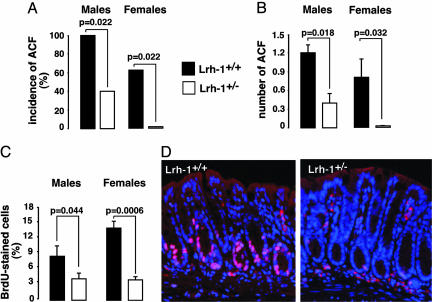Fig. 2.
Haploinsufficiency of LRH-1 reduces azoxymethane-induced neoplasia. (A) Incidence of mice with ACF in male and female Lrh-1+/+ and Lrh-1+/– mice after short-term treatment with AOM. Six-week-old animals (n = 5 per gender and per genotype) were injected i.p. twice for 2 weeks with 7.5 mg/kg AOM and killed 5 weeks after the first injection. Analysis of the colon is described in Experimental Procedures. Statistical significance (P < 0.05; χ2 test) is indicated. (B) Total number of ACF in male and female Lrh-1+/+ and Lrh-1+/– mice (n = 5 per genotype and gender). Comparisons were only performed between littermates. (C) BrdUrd labeling index expressed as the percentage of BrdUrd-positive cells in the colon of male and female BrdUrd-injected Lrh-1+/+ and Lrh-1+/– littermates. BrdUrd immunostaining was performed as described in Experimental Procedures. Percentage of BrdUrd-positive cells represents the number of BrdUrd-positive epithelial cells compared with the total number of epithelial cells in three random fields (×200). (D) BrdUrd immunofluorescence staining of colon sections from BrdUrd-injected Lrh-1+/+ and Lrh-1+/– mice that were challenged with AOM.

